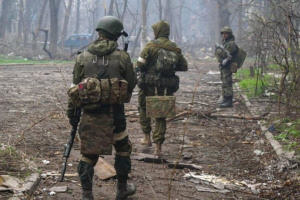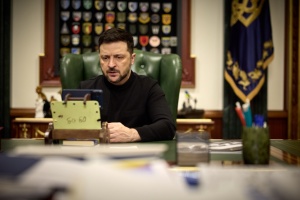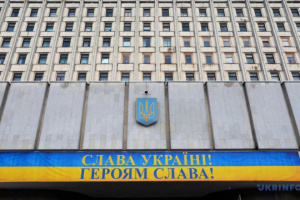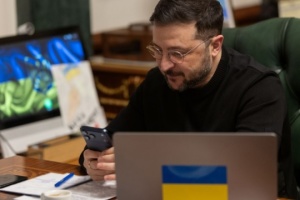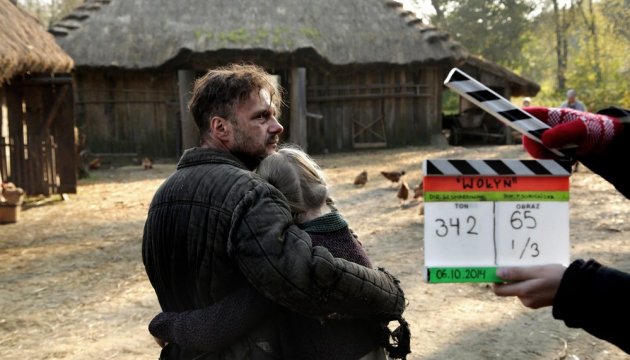
‘Volyn’: the film that kills
The Volyn fictional film was first presented on September 23, while participating in the official selection of the 41st Gdynia Film Festival, the most respected artistic event in the Polish cinematography. The first official premiere of the film has been scheduled for October 3, and it is expected to be released to the general public in Poland on October 7.
One can confidently say that this film may be a mine laid under the basis of Ukrainian-Polish relations. And it will depend solely on Ukrainians and Poles whether the mine explodes or not…
WITH GOOD INTENTIONS…
One could have expected that sooner or later somebody would take up the screen adaptation of tragic events in Volyn during the World War II. They used to be a taboo subject for many years in communist Poland, and filmmakers were avoiding it in democratic Poland as well. However, a person who finally addressed it has been found. It is Wojciech Smarzowski, a film director known as Polish ‘Quentin Tarantino’ for filling his films with sensitive graphic content that evokes a storm of emotions and sharpens the perception of the plot.
According to Smarzowski, the film is needed to ‘build bridges’, initiate an active dialogue between Ukrainians and Poles concerning the Volyn events. In his opinion, the film should encourage reflection, deep thinking and, eventually, historical studies. Prior to the premiere, Smarzowski repeatedly noted that he realized what emotions could be triggered by this film. But he supposed that feelings would soon settle down, and historians and investigators would calmly take up their work, and politicians of the two countries would ensure necessary climate for that. However, he also added that he was not able to predict further effects of the emotions evoked by the film. Smarzowski started to work on the film four years ago, prior to Euromaidan and the war between Ukraine and Russia. Circumstances have drastically changed since then, and certain subjects, namely the Volyn tragedy, are perceived very sharply and are an element of the anti-Ukrainian propaganda conducted by Russia.
Being aware that the subject is very complex and ambiguous, the film director, according to him, has thoroughly studied the course of events of the late 1930s and the early 1940s, read relevant books and consulted the experts. However, Smarzowski admitted that he obtained information from Polish sources only, having actually ignored the arguments of the Ukrainian side. Probably, it was one of primary mistakes he had made while creating the film.
The film raised doubts at the very initial stage. Many sponsors refused to provide support, having familiarized with the film script and having realized probable consequences. Smarzowski had to publicly address all concerned parties to complete film production. However, some claim that he had enough funds and it was a marketing ploy to draw attention to the film. Some also say that many people who had initially started to work with the film director turned down their roles due to the overload of graphic content in the film. Nevertheless, Smarzowski finished the film, being confident in the importance of his mission…
According to the well-known proverb, the road to Hell is paved with good intentions. It is a good description for the end result of Smarzowski’s work.
TARANTINO’S STYLE: RIVERS OF BLOOD AND HORRORS OF TORTURE
We must give credit to the film director. The film has been done professionally with a focus on every detail to make it very realistic and convincing. The general atmosphere of the Volyn village and actors’ costumes were depicted true-to-life. Polish actors even had to study a specific local dialect, while the Ukrainian characters were played by actors from Ukraine and their dialogues were accompanied with Polish subtitles.
The film starts with joyful events, wedding and careless feasts, which make the audience feel cheerful. The audience hopes that joy will last throughout the film, or at least the film will not be too scary. However, the ‘honey’ stage of the film ends, and the true slaughter begins lasting until the end of the film. The sensitive graphic content (eye gauging, beheading and dismembering, belly ripping, skin removal from a live person, burning alive etc.) make the audience sweat, turn away and close the eyes.
JEALOUS UKRAINIANS, PROSPEROUS POLES AND NAZI ‘DEFENDERS’
The main lady character is Zosia Głowacka, a 17-year-old Polish girl who is in love with a Ukrainian fellow villager, but her father gives her in marriage, or actually sells, to Maciej Skiba, a widower who is much older than the girl. The peaceful life of farmers is broken by the World War II and the Soviet occupation followed by the German occupation and the events recorded in history as the Volyn tragedy.
In general, the Ukrainian is depicted in the film as a cunning and jealous neighbor of more prosperous Poles, stealing everything and ready to collaborate with any occupier. The Ukrainian in the film can be either a treacherous nationalist taking pleasure in massacre, or a pope blessing pitchforks and scythes of Ukrainian nationalists and calling on them to clean the land from Poles. The film director also tries to depict good Ukrainians, such as another pope calling to save the human face in hard times or Ukrainians saving Poles, but even positive characters have their own mercantile interests.
In contrast, Poles in the film are either prosperous farmers with great dignity, or officers who are ready to give life for their native land at any time. However, it is worth noting that Smarzowski also showed Poles slaughtering a Ukrainian village at the end of the film to maintain balance between the ‘good’ and the ‘bad’.
The Nazi image is rather unclear in the film. Sometimes it looks like the Hitlerites in Volyn were not occupiers but rather peacekeepers defending Poles from Ukrainians.
SUBJECTIVITY AS SIMPLIFIED AND DANGEROUS ANSWER TO HISTORICAL QUESTION
While working on the film script, Smarzowski tried to cover the most screaming facts of the Volyn tragedy in 120 minutes. However, all of them were depicted against the background of one village, and general public could have thought that such a horrible mixture was in every Volyn village. Unfortunately, the film director has not mentioned the harassment of Ukrainians by the Polish state until 1939, depicting careless multicultural peace and harmony at the beginning of the film rather than obvious social tension which resulted in the horrible fall of human dignity.
Polish general public, unaware of historical details, will definitely have a negative stereotype of modern Ukrainians after watching the film, unfortunately. And whatever they say about the need to ‘tell the truth’ and ‘build bridges’, the film is the author’s subjective perception of the events based on individual memories rather than historical archive documents. But most people in Poland do not bother with the cause-and-effect linkage of historical events. They want to see simple answers to complex questions, and they actually get them.
Obviously, they will take the film for a historical document and the ultimate truth, which is rather horrible. Several hundreds of thousands of Ukrainians live in Poland, while anti-immigrant and xenophobic spirits are running high in Europe. That is what Smarzowski is afraid of, and that is what the Polish authorities are getting afraid of and, probably, starting to prepare for the worst. Over the past two years, many Ukrainian monuments have been destroyed in Poland. Ukrainian churches suffered from desecration, and aggressive youngsters attacked a Ukrainian sacred procession in Przemyśl in summer. The Polish authorities explained everything by disruptive behavior rather than xenophobia and ethnic hostility. Now the film can add fuel to the controversy.
POLISH DOSTOYEVSKY’S GIFT TO MOSCOW
However, Polish reviews of the film are positive, even too positive. The film makers organized private screening for journalists from different mass media sources, who were generous with positive comments.
“The film is as truthful as an accomplished work by a mature artist can be,” one of the authors has noted, adding that it is probably the best historical film ever produced in Poland.
The other author is taking up the idea: “The film is the study of evil, and Smarzowski is like modern Dostoyevsky in cinema.”
The authors are discussing the response of Ukrainians to this film. One of them assures that Ukrainians will take it painfully. But if they want to be honest with themselves and pass through ‘the Volyn catharsis’, they should treat it calmly. The other author notes that the film fairly divides the guilt between Poles, Ukrainians, Germans and the ‘Soviets’. However, most of them doubt that the film will be released to the general public in Ukraine.
Talking of Russia, one of journalists states that the film was created in the most unfavorable time when the Russian propaganda can effectively use it to fight against Ukraine. The other one believes that the film will not be released in Russia too, as it negatively depicts the Soviet period of Volyn’s occupation. However, we are tempted to say that Russia is hardly bothered with that, as the propaganda can effectively manipulate the facts, showing some pictures and hiding the others. Kremlin channels can easily cut scenes from the film to frighten Russian citizens and foreigners with Ukrainian ‘neo-Banderites’ and ‘fascists’.
According to the other journalist, one of advisors to the Polish president has supposed that the ‘black scenario’ is possible and the situation may run out of control with the assistance of Russian agents and Polish nationalists, resulting in a threat to the country’s security.
One of the authors tries to take a look into the future of Ukrainian-Polish relations after the Volyn film release, saying that the film will set off a bomb that should have exploded long ago, and the end can be hardly predicted.
Now it is time to answer the main questions. Should they have produced the film, and has it reflected the truth? Of course, Smarzowski had a right to screen the film. However, it is a matter of opinion whether the audience should have been shocked with the acts of violence, as aggression gives rise to aggression. The film can neither be called unprejudiced, as it reflects the author’s subjective perception based on memories of Polish witnesses. Meanwhile, the Ukrainian point of view has not been presented in the film at all.
And finally, what should we expect from it? It is the most difficult question. No one can predict what direction the hot lava of human emotions may take. Perhaps, the earthquake will not happen at all. Who knows? But it is obvious that the Volyn film will soon be objective reality with unpredictable consequences considered on both sides of the border.
Yury Banakhevych, Warsaw

